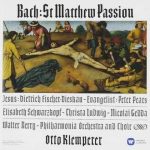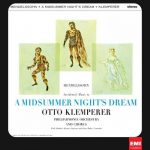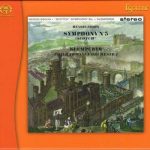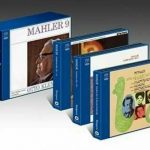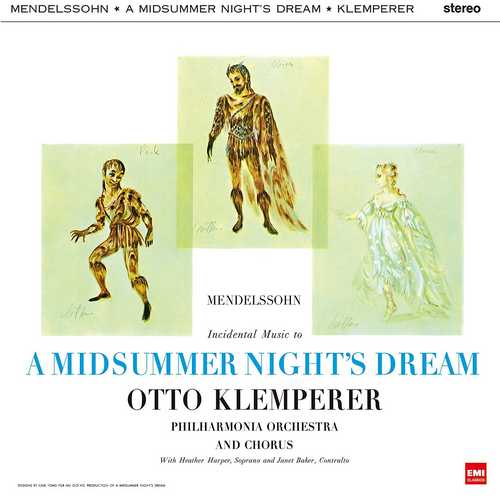
Composer: Felix Mendelssohn
Performer: Philharmonia Chorus
Orchestra: Philharmonia Orchestra
Conductor: Otto Klemperer
Number of Discs: 1
Format: DSD64 (iso)
Label: EMI
Release: 2011
Size: 1.95 GB
Recovery: +3%
Scan: yes
Felix Mendelssohn Bartholdy
A Midsummer Night’s Dream Op. 61
01. Overture Op. 21
02. Scherzo Op. 61 No. 1 (Allegro Vivace)
03. March Of The Fairies Op. 61 No. 2a (Allegro Vivace)
04. Ye Spotted Snakes Op. 61 No. 3 (Allegro Ma Non Troppo)
05. Intermezzo Op. 61 No. 5 (Allegro Appassionato)
06. Nocturne Op. 61 No. 7 (Andante Tranquillo)
07. Wedding March Op. 61 No. 9 (Allegro Vivace)
08. Funeral March Op. 61 No. 10a (Andante Comodo)
09. Dance Of The Clowns Op. 61 No. 11 (Allegro Di Molto)
10. Finale Op. 61 No. 13 ‘Tro’ This House Give Glimm’ring Light’ (Allegro Di Molto)
Otto Klemperer conducts the Philharmonia Orchestra & Chorus for this recording of Mendelssohn’s Incidental Music to Shakespeare’s Midsummer Night’s Dream.
Otto Klemperer was very much a man of the theatre. “Here, opera & drama were truly united,” he said of his time at Berlin’s Kroll Theatre, a progressive & influential force in the heady years of the Weimar Republic. He was also a man with a sharp sense of humour: this performance of Mendelssohn’s incidental music to Shakespeare’s A Midsummer Night’s Dream both glows with enchantment & sparkles with wit.
In September I welcomed Previn’s CD of A Midsummer Night’s Dream incidental music (which is absolutely complete) on EMI, rating it as the best on all counts, but did mention that this Klemperer version was on the way. It does not displace Previn, for it is not complete & with only 49 minutes of music not particularly generous. But it offers some pretty marvellous Philharmonia playing—the Scherzo, taken slower than usual but not in the least heavy, is the finest on record—and many inimitable touches. The intermezzo is a delight & the Wedding March, without losing its sense of joy, has superb grandeur in Klemperer’s hands. The 1960 recording sounds as fresh as new paint, all veils now lifted, & is yet another example of Walter Legge’s special skills. Detail is radiantly vivid, the balance is splendid & the sound hardly dates at all. I certainly prefer this to the Marriner collection on Philips, which has the advantage of modern digital recording. The singers, with Klemperer, both soloists & chorus, are 1st rate, & this is very enjoyable.
I, personally, would opt for the cassette which sounds pretty good too & costs little more than a quarter of the price of the CD. But Klemperer admirers who insist on the CD format will find this 1 shows his art at its most telling.’Inspired by William Shakespeare’s comedy A Midsummer Night’s Dream, Felix Mendelssohn completed his famous eponymous Overture in 1826. The stunning accomplishment the Overture represents testifiies not only to the creative maturity of the 17-year-old composer, but also to Mendelssohn’s music as the embodiment of the Romantic ideal of the marriage of music & poetry. A passionate literary scholar, Mendelssohn was particularly bewitched by the works of Shakespeare, whose collected plays had been translated into German in 1801. In fact, this translation, the work of Ludwig Tieck & August Wilhelm Schlegel, quickly became 1 of the great literary monuments of German Romanticism. The Overture exemplifies Mendelssohn’s ability to create extraordinarily imaginative & atmospheric music while remaining within the context of traditional harmonic & formal structure. Mendelssohn masterfully translates the 3 worlds (1 of which is supernatural) of the comedy’s universe into music of singular distinction.
The abode of Titania & Oberon is introduced by gossamer, almost breathless, violin figures in E minor, the key which defines the fairy world. With a facility fully equal to Shakespeare’s, Mendelssohn moves back & forth from the fairy kingdom to the realm of humanity, piercing the misty atmosphere of E minor with chordal themes in E major (the key of Duke Theseus’ court) that evoke columns of light. The earthy province of Bottom & his primitive cohorts is depicted by a drone of open 5ths, along with realistic representations of sounds such as a donkey’s braying. Like Shakespeare, Mendelssohn identifies the ducal court as the safe, intelligible, radiant realm that human beings long for, life as it should be: inspired, but not spectral; tangible, but not primitive. The essence of the middle world, in which the contradictory forces of spirit & earth are reconciled in civilized tranquility, surfaces as a characteristic theme based on a descending scale motion. This motion, though apparently simple, nonetheless releases intimations of many joyful sentiments sparked by an overwhelming wave of life energy. 17 years after the composition of the Overture, Mendelssohn rounded out the entire incidental score, adding the famously sprightly Scherzo, the Intermezzo, Notturno, & the celebrated Wedding March for a production of the play at the Royal Theater in Berlin in 1842. Although composed only 4 years before Mendelssohn’s death, these numbers emanate a truly youthful energy, complementing the Overture’s musical narrative with scenes of exceptional charm.
